Emo
Emo /ˈiːmoʊ/ is a rock music genre characterized by an emphasis on emotional expression, sometimes through confessional lyrics. It emerged as a style of post-hardcore from the mid-1980s hardcore punk movement in Washington, D.C., where it was known as emotional hardcore or emocore and pioneered by bands such as Rites of Spring and Embrace. In the early–mid 1990s, emo was adopted and reinvented by alternative rock, indie rock and pop punk bands such as Sunny Day Real Estate, Jawbreaker, Weezer and Jimmy Eat World, with Weezer breaking into the mainstream during this time. By the mid-1990s, bands such as Braid, the Promise Ring and the Get Up Kids emerged from the burgeoning Midwest emo scene, and several independent record labels began to specialize in the genre. Meanwhile, screamo, a more aggressive style of emo using screamed vocals, also emerged, pioneered by the San Diego bands Heroin and Antioch Arrow. Screamo achieved mainstream success in the 2000s with bands like Hawthorne Heights, Silverstein, Story of the Year, Thursday, The Used, and Underoath.
| Emo | |
|---|---|
| Other names |
|
| Stylistic origins |
|
| Cultural origins |
|
| Typical instruments | |
| Subgenres | |
| Fusion genres | |
| Emo rap | |
| Regional scenes | |
| Other topics | |
| Scene | |
Often seen as a subculture, emo also signifies a specific relationship between fans and artists and certain aspects of fashion, culture and behavior. Emo fashion has been associated with skinny jeans; tight t-shirts with band names; studded belts; and flat, straight, jet-black hair with long bangs. Fans of emo music who dress like this are referred to as "emo kids" or "emos". Emos are known for listening to emo bands like My Chemical Romance, Fall Out Boy, Hawthorne Heights, The Used, and AFI. The emo subculture is stereotypically associated with emotion, sensitivity, misanthropy, shyness, introversion and angst, as well as depression, self-harm and suicide. Its quick rise in popularity in the early 2000s inspired a backlash, with bands such as My Chemical Romance and Panic! at the Disco rejecting the emo label because of the social stigma and controversy surrounding it.
Emo and its subgenre emo pop entered mainstream culture in the early 2000s with the success of Jimmy Eat World and Dashboard Confessional and many artists signed to major record labels. Bands such as My Chemical Romance, AFI, Fall Out Boy and the Red Jumpsuit Apparatus continued the genre's popularity during the rest of the decade. By the early 2010s, emo's popularity had declined, with some groups changing their sound and others disbanding. Meanwhile, however, a mainly underground emo revival emerged, with bands such as The World Is a Beautiful Place & I Am No Longer Afraid to Die and Modern Baseball drawing on the sound and aesthetic of 1990s emo. During the late 2010s, a fusion genre called emo rap was mainstream, with some of emo rap's most famous artists including XXXTentacion, Juice WRLD, and Lil Peep.
Characteristics

Emo originated in hardcore punk[1][2] and is considered a form of post-hardcore.[3] Nonetheless, emo has also been considered a genre of alternative rock,[4] indie rock[5] and pop punk.[6][7] Emo uses the guitar dynamics that use both the softness and loudness of punk rock music.[8] Some emo leans uses characteristics of progressive music with the genre's use of complex guitar work, unorthodox song structures, and extreme dynamic shifts.[1]
Lyrics, a focus in emo music, are typically emotional and often personal or confessional,[8] dealing with topics such as failed romance,[9] self-loathing, pain, insecurity, suicidal thoughts, love, and relationships.[8] AllMusic described emo lyrics as "usually either free-associative poetry or intimate confessionals".[1] Early emo bands were hardcore punk bands that used melody and emotional or introspective lyrics and that were less structured than regular hardcore punk, making early emo bands different from the aggression, anger, and verse-chorus-verse structures of regular hardcore punk.[10]
According to AllMusic, most 1990s emo bands "borrowed from some combination of Fugazi, Sunny Day Real Estate, and Weezer".[1] The New York Times described emo as "emotional punk or post-hardcore or pop-punk. That is, punk that wears its heart on its sleeve and tries a little tenderness to leaven its sonic attack. If it helps, imagine Ricky Nelson singing in the Sex Pistols."[11] Author Matt Diehl called emo a "more sensitive interpolation of punk's mission".[9] According to Merriam-Webster, emo is "a style of rock music influenced by punk rock and featuring introspective and emotionally fraught lyrics".[12]
History

Predecessors
Pet Sounds, the Beach Boys' 1966 album, is sometimes considered the first emo album. According to music writer Luke Britton, such assertions are perhaps stated "wryly", and wrote that "it’s generally accepted that the genre's pioneers" came later in the 1980s.[13] During the decade, many hardcore punk and post-hardcore bands formed in Washington, D.C.. Post-hardcore, an experimental offshoot of hardcore punk, was inspired by post-punk.[14] Hardcore punk bands and post-hardcore bands who influenced early emo bands include Minor Threat,[15] Black Flag and Hüsker Dü.[16]
1984–1991: Origins
Emo, which began as a post-hardcore subgenre,[3] was part of the 1980s hardcore punk[1] scene in Washington, D.C. as something different from the violent part of the Washington, D.C. hardcore scene.[10][17][18] Minor Threat fan Guy Picciotto formed Rites of Spring in 1984, using the musical style of hardcore punk and combining the musical style with melodic guitars, varied rhythms, and personal, emotional lyrics.[15] Many of the band's themes, including nostalgia, romantic bitterness and poetic desperation, became familiar tropes of later emo music.[19] Its performances were public, emotional purges where audience members sometimes wept.[20] Ian MacKaye of Minor Threat became a Rites of Spring fan (recording their only album and being their roadie) and formed the emo band Embrace, which explored similar themes of self-searching and emotional release.[21] Similar bands followed in connection with the "Revolution Summer” of 1985, an attempt by members of the Washington scene to break from the usual characteristics of hardcore punk to a hardcore punk style with different characteristics.[18] Bands such as Gray Matter, Beefeater, Fire Party, Dag Nasty, and Soulside were associated with the movement.[21][18]
Although the origins of the word "emo" are uncertain, evidence shows that the word "emo" was coined in the mid-1980s, specifically 1985. According to Andy Greenwald, author of Nothing Feels Good: Punk Rock, Teenagers, and Emo, "The origins of the term 'emo' are shrouded in mystery ... but it first came into common practice in 1985. If Minor Threat was hardcore, then Rites of Spring, with its altered focus, was emotional hardcore or emocore."[21] Michael Azerrad, author of Our Band Could Be Your Life, also traces the word's origins to the mid-1980s: "The style was soon dubbed 'emo-core,' a term everyone involved bitterly detested".[22] MacKaye traces it to 1985, attributing it to an article in Thrasher magazine referring to Embrace and other Washington, D.C. bands as "emo-core" (which he called "the stupidest fucking thing I've ever heard in my entire life").[23] Other accounts attribute the word to an audience member at an Embrace show, who shouted as an insult that the band was "emocore".[24][25] Others have said that MacKaye coined the word when he used it self-mockingly in a magazine, or that it originated with Rites of Spring.[25] The "emocore" label quickly spread through the DC punk scene, and was associated with many bands associated with Ian MacKaye's Dischord Records.[24] Although many of the bands rejected the term, it stayed. Jenny Toomey recalled, "The only people who used it at first were the ones that were jealous over how big and fanatical a scene it was. [Rites of Spring] existed well before the term did and they hated it. But there was this weird moment, like when people started calling music 'grunge,' where you were using the term even though you hated it."[26] The Washington, D.C. emo scene lasted only a few years, and by 1986, most of emo's major bands (including Rites of Spring, Embrace, Gray Matter and Beefeater) had broken up.[27] However, its ideas and aesthetics spread quickly across the country through a network of homemade zines, vinyl records and hearsay.[28] According to Greenwald, the Washington, D.C. scene laid the groundwork for emo's subsequent incarnations:
What had happened in D.C. in the mid-eighties—the shift from anger to action, from extroverted rage to internal turmoil, from an individualized mass to a mass of individuals—was in many ways a test case for the transformation of the national punk scene over the next two decades. The imagery, the power of the music, the way people responded to it, and the way the bands burned out instead of fading away—all have their origins in those first few performances by Rites of Spring. The roots of emo were laid, however unintentionally, by fifty or so people in the nation's capital. And in some ways, it was never as good and surely never as pure again. Certainly, the Washington scene was the only time "emocore" had any consensus definition as a genre.[29]
1991–1994: Reinvention
As the Washington, D.C. emo movement spread across the United States, local bands began to emulate its style.[30] Emo combined the fatalism, theatricality and isolation of The Smiths with hardcore punk's uncompromising, dramatic worldview.[30] Despite the number of bands and the variety of locales, emocore's late-1980s aesthetics remained more-or-less the same: "over-the-top lyrics about feelings wedded to dramatic but decidedly punk music."[30] During the early–mid 1990s, several new bands reinvented emo,[31] making emo expand by becoming a subgenre of genres like indie rock and pop punk.[1] Chief among them were Jawbreaker and Sunny Day Real Estate, who inspired cult followings, redefined emo and brought it a step closer to the mainstream.[31] In the wake of the 1991 success of Nirvana's Nevermind, underground music and subcultures were widely noticed in the United States. New distribution networks emerged, touring routes were codified, and regional and independent acts accessed the national stage.[31] Young people across the country became fans of independent music, and punk culture became mainstream.[31]

Emerging from the late 1980s and early 1990s San Francisco punk rock scene and forming in New York City, Jawbreaker combined pop punk with emotional and personal lyrics.[33][34][35] Singer-guitarist Blake Schwarzenbach focused his lyrics on personal, immediate topics often taken from his journal.[33] Often obscure and cloaked in metaphors, their relationship to Schwarzenbach's concerns gave his words a bitterness and frustration which made them universal and attractive to audiences.[36] Schwarzenbach became emo's first idol, as listeners related to the singer even more than to his songs.[36] Jawbreaker's 1994 album, 24 Hour Revenge Therapy, was popular with fans and is a touchstone of mid-1990s emo.[37] Although Jawbreaker signed with Geffen Records and toured with mainstream bands Nirvana and Green Day, Jawbreaker's 1995 album Dear You did not achieve mainstream success. Jawbreaker broke up soon afterwards, with Schwarzenbach forming emo band Jets to Brazil.[38]
Sunny Day Real Estate formed in Seattle at the height of the early-1990s grunge boom.[39] The music video for "Seven", lead track of the band's debut album Diary (1994), was played on MTV, giving the band more attention.[40] Another emo band which emerged at the same time was California's Weezer, which also released its self-titled debut album in 1994.[41] Also known as the Blue Album, Weezer's self-titled album was certified 2x platinum by the Recording Industry Association of America (RIAA) on August 8, 1995 and was certified 3x platinum by the RIAA on November 13, 1998. As of August 2009, Weezer's self-titled album sold at least 3,300,000 copies in the United States.[42] According to NME, Weezer's debut album "pretty much invented emo's melodic wing".[43] Jimmy Eat World, an Arizona emo band, also emerged at this time. Influenced by pop punk bands such as the Mr. T Experience and Horace Pinker,[44] Jimmy Eat World released its self-titled debut album in 1994.[45]
1994–1997: Underground popularity
The American punk and indie rock movements, which had been largely underground since the early 1980s, became part of mainstream culture during the mid-1990s. With Nirvana's success, major record labels capitalized on the popularity of alternative rock and other underground music by signing and promoting independent bands.[46] In 1994, the same year that Jawbreaker's 24 Hour Revenge Therapy and Sunny Day Real Estate's Diary were released, punk rock bands Green Day and the Offspring broke into the mainstream with diamond album Dookie[47] and 6x platinum album Smash,[48] respectively. After underground music went mainstream, emo retreated and reformed as a national subculture over the next few years.[46] Inspired by Jawbreaker, Drive Like Jehu and Fugazi, the new emo was a mixture of hardcore punk passion and indie-rock intelligence, with punk rock's anthemic power and do-it-yourself work ethic but smoother songs, sloppier melodies and yearning vocals.[49]
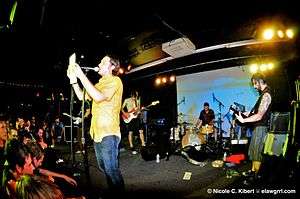
Many new emo bands, such as Cap'n Jazz, Braid, Christie Front Drive, Mineral, Jimmy Eat World, the Get Up Kids and the Promise Ring, originated in the central U.S.[50] Many of the bands had a distinct vocal style and guitar melodies, which was later called midwest emo.[51] According to Andy Greenwald, "this was the period when emo earned many, if not all, of the stereotypes that have lasted to this day: boy-driven, glasses-wearing, overly sensitive, overly brainy, chiming-guitar-driven college music."[49] Emo band Texas Is the Reason bridged the gap between indie rock and emo in their three-year lifespan on the East Coast, melding Sunny Day Real Estate's melodies and punk musicianship and singing directly to the listener.[52] In New Jersey, the band Lifetime played shows in fans' basements.[53] Lifetime's 1995 album, Hello Bastards on Jade Tree Records, fused hardcore punk with emo and eschewed cynicism and irony in favor of love songs.[53] The album sold tens of thousands of copies,[54] and Lifetime paved the way for New Jersey and Long Island emo bands Brand New, Midtown,[55] The Movielife, My Chemical Romance,[55] Saves the Day,[55][56] Senses Fail,[55] Taking Back Sunday[54][55] and Thursday.[55][57]
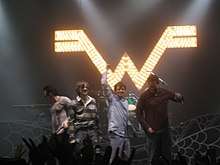
The Promise Ring's music took a slower, smoother, pop punk approach to riffs, blending them with singer Davey von Bohlen's imagist lyrics delivered in a froggy croon and pronounced lisp and playing shows in basements and VFW halls.[59] Jade Tree released their debut album, 30° Everywhere, in 1996; it sold tens of thousands of copies and was successful by independent standards.[60] Greenwald describes the album as "like being hit in the head with cotton candy."[61] Other bands, such as Karate, the Van Pelt, Joan of Arc and the Shyness Clinic, played emo music with post-rock and noise rock influences.[62] Their common lyrical thread was "applying big questions to small scenarios."[62] A cornerstone of mid-1990s emo was Weezer's 1996 album, Pinkerton.[63] After the mainstream success of Weezer's self-titled debut album, Pinkerton showed a more dark and abrasive style.[64][65] Frontman Rivers Cuomo's songs focused on messy, manipulative sex and his insecurity about dealing with celebrity.[65] A critical and commercial failure,[65][66] Rolling Stone called it the second-worst album of the year.[67] Cuomo retreated from the public eye,[65] later referring to the album as "hideous" and "a hugely painful mistake".[68] However, Pinkerton found enduring appeal with young people who were discovering alternative rock and identified with its confessional lyrics and theme of rejection.[58] Sales grew steadily due to word of mouth, online message boards and Napster.[58] "Although no one was paying attention", writes Greenwald, "perhaps because no one was paying attention—Pinkerton became the most important emo album of the decade."[58] In 2004, James Montgomery of MTV described Weezer as "the most important band of the last 10 years".[69] Pinkerton's success grew very gradually, being certified gold by the RIAA in July 2001 and eventually being certified platinum by the RIAA in September 2016.[70]
Mid-1990s emo was embodied by Mineral, whose The Power of Failing (1997) and EndSerenading (1998) encapsulated emo tropes: somber music, accompanied by a shy narrator singing seriously about mundane problems.[71] Greenwald calls "If I Could" "the ultimate expression of mid-nineties emo. The song's short synopsis—she is beautiful, I am weak, dumb, and shy; I am alone but am surprisingly poetic when left alone—sums up everything that emo's adherents admired and its detractors detested."[71] Another significant band was Braid, whose 1998 album Frame and Canvas and B-side song "Forever Got Shorter" blurred the line between band and listener; the group mirrored their audience in passion and sentiment, and sang in their fans' voice.[72]
Although mid-1990s emo had thousands of young fans, it did not enter the national consciousness.[74] A few bands were offered contracts with major record labels, but most broke up before they could capitalize on the opportunity.[75] Jimmy Eat World signed to Capitol Records in 1995 and developed a following with their album, Static Prevails, but did not break into the mainstream yet.[76] The Promise Ring were the most commercially successful emo band of the time, with sales of their 1997 album Nothing Feels Good reaching the mid-five figures.[74] Greenwald calls the album "the pinnacle of its generation of emo: a convergence of pop and punk, of resignation and celebration, of the lure of girlfriends and the pull of friends, bandmates, and the road";[77] mid-1990s emo was "the last subculture made of vinyl and paper instead of plastic and megabytes."[78]
1997–2002: Increased popularity
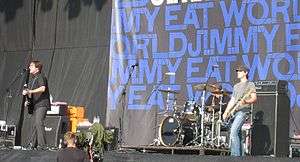
Emo's popularity grew during the late 1990s, laying the foundation for mainstream success. Deep Elm Records released a series of eleven compilation albums, The Emo Diaries, from 1997 to 2007.[79] Emphasizing unreleased music from many bands, the series included Jimmy Eat World, Further Seems Forever, Samiam and The Movielife.[79] Jimmy Eat World's 1999 album, Clarity, was a touchstone for later emo bands.[80] In 2003, Andy Greenwald called Clarity "one of the most fiercely beloved rock 'n' roll records of the last decade."[80] Despite a warm critical reception and the promotion of "Lucky Denver Mint" in the Drew Barrymore comedy Never Been Kissed, Clarity was commercially unsuccessful.[81] Nevertheless, the album had steady word-of-mouth popularity and eventually sold over 70,000 copies.[82] Jimmy Eat World self-financed their next album, Bleed American (2001), before signing with Dreamworks Records. The album sold 30,000 copies in its first week, went gold shortly afterwards and went platinum in 2002, making emo become mainstream.[83]
Drive-Thru Records (founded in 1996) developed a roster of primarily pop punk bands with emo characteristics, including Midtown, The Starting Line, The Movielife and Something Corporate.[84] Drive-Thru's partnership with MCA Records enabled its brand of emo-inflected pop to reach a wider audience.[85] The label's greatest early success was New Found Glory,[85] whose eponymous 2000 album reached number 107 on the Billboard 200[86] and single "Hit or Miss" reached number 15 on the Alternative Songs chart.[87] Drive-Thru's unabashedly populist, capitalist approach to music allowed its bands' albums and merchandise to sell in stores such as Hot Topic.[88]
Independent label Vagrant Records signed several successful late-1990s and early-2000s emo bands. The Get Up Kids had sold over 15,000 copies of their debut album, Four Minute Mile (1997), before signing with Vagrant. The label promoted them aggressively, sending them on tours opening for Green Day and Weezer.[89] Their 1999 album, Something to Write Home About, reaching number 31 on Billboard's Top Heatseekers chart.[90] Vagrant signed and recorded a number of other emo-related bands over the next two years, including The Anniversary, Reggie and the Full Effect, The New Amsterdams, Alkaline Trio, Saves the Day, Dashboard Confessional, Hey Mercedes and Hot Rod Circuit.[91] Saves the Day had developed a substantial East Coast following and sold almost 50,000 copies of their second album, Through Being Cool (1999),[56] before signing with Vagrant and releasing Stay What You Are (2001). Stay What You Are sold 15,000 copies in its first week,[92] reached number 100 on the Billboard 200[93] and sold at least 120,000 copies in the United States.[94] The band Blink-182's song "Adam's Song" is considered an emo song.[95] The song, which is from Blink-182's 1999 5x platinum[96] album Enema of the State, peaked at number two on the Alternative Songs chart on April 29, 2000.[97]
Vagrant organized a national tour with every band on its label, sponsored by corporations including Microsoft and Coca-Cola, during the summer of 2001. Its populist approach and use of the internet as a marketing tool made it one of the country's most-successful independent labels and helped popularize the word "emo".[98] According to Greenwald, "More than any other event, it was Vagrant America that defined emo to masses—mainly because it had the gumption to hit the road and bring it to them."[92] Weezer returned in the early 2000s with a pop music-influenced sound.[99] Cuomo refused to play songs from Pinkerton, calling it "ugly" and "embarrassing".[100] Weezer released their Green Album in 2001. The Green Album was described as emo pop by AllMusic[99] and the album was certified platinum by the RIAA on September 13, 2001.[101] As of August 2009, Weezer's Green Album has sold 1,600,000 copies.[42]
2002–2010: Mainstream
Emo broke into the mainstream media during the summer of 2002.[102] During this time, many fans of emo music had an appearance of short, dyed black hair with bangs cut high on the forehead, glasses with thick and black frames, and thrift store clothes. This fashion then became a huge part of emo's identity.[105] Jimmy Eat World's Bleed American album went platinum on the strength of "The Middle", which topped Billboard's Alternative Songs chart.[102][103][106] The mainstream success achieved by Jimmy Eat World paved the way for emo pop music that would appear during the rest of the 2000s,[99] with emo pop becoming a very common style of emo music during the 2000s.[107] After releasing their Green Album in 2001, Weezer released another album in 2002 called Maladroit. Maladroit was certified gold by the RIAA 31 days after being released.[108] The band Dashboard Confessional broke into the mainstream. Started by the band's guitarist and lead vocalist Chris Carrabba, Dashboard Confessional are known for sometimes creating acoustic songs.[109] Dashboard Confessional originally was a side project, as Carrabba was also a member of the emo band Further Seems Forever,[109] and Vacant Andys, a punk rock band Carraba helped start in 1995.[110] Dashboard Confessional's album The Places You Have Come to Fear the Most peaked at number 5 on the Independent Albums chart.[104] Dashboard Confessional was the first non-platinum-selling artist to record an episode of MTV Unplugged.[102] The 2002 resulting live album and video long-form was certified platinum by the RIAA on May 22, 2003, topped the Independent Albums chart, and, as of October 19, 2007, sold 316,000 copies.[104][109][111] With Dashboard Confessional's mainstream success, Carrabba appeared on a cover of the magazine Spin and according to Jim DeRogatis, "has become the 'face of emo' the way that Moby was deemed the prime exponent of techno or Kurt Cobain became the unwilling crown prince of grunge."[112] Three of Dashboard Confessional's studio albums, The Places You Have Come to Fear the Most (2001), A Mark, a Mission, a Brand, a Scar (2003), and Dusk and Summer (2006), all were certified gold by the RIAA during the mid-2000s.[111] As of October 19, 2007, The Places You Have Come to Fear the Most has sold 599,000 copies.[113] As of October 19, 2007, Dusk and Summer and A Mark, a Mission, a Brand, a Scar have sold 512,000 copies and 901,000 copies in the United States, respectively.[113] As of October 19, 2007, Dashboard Confessional's 2000 debut album The Swiss Army Romance sold 338,000 copies.[113] Dashboard Confessional's songs "Stolen" and "Don't Wait" peaked at number 44 on the Billboard Hot 100 on May 19, 2007 and number 80 on the Billboard Hot 100 in 2006, respectively.[114] New Found Glory's album, Sticks and Stones, debuted at number four on the Billboard 200.[102][115] The Get Up Kids' 2002 album, On a Wire, peaked at number 57 on the Billboard 200 and number three on Top Independent Albums chart. Their 2004 album, Guilt Show, peaked at number 58 on the Billboard 200.[116] On August 10, 2003, The New York Times reported how, "from the three-chord laments of Alkaline Trio to the folky rants of Bright Eyes, from the erudite pop-punk of Brand New" to the entropic anthems of Thursday, much of the most exciting rock music" was appearing from the emo genre.[117]
Saves the Day toured with Green Day, Blink-182 and Weezer, playing in large arenas such as Madison Square Garden.[118] Saves the Day performed on Late Night with Conan O'Brien, appeared on the cover of Alternative Press and had music videos for "At Your Funeral" and "Freakish" in rotation on MTV2.[92][119] Taking Back Sunday released their debut album, Tell All Your Friends, on Victory Records in 2002. The album gave the band a taste of success in the emo scene with singles such as "Cute Without the 'E' (Cut from the Team)" and "You're So Last Summer". Initially charting at number 183 on the Billboard 200, Tell All Your Friends was eventually certified gold by the RIAA in 2005[120] and is considered one of emo's most-influential albums. As of May 8, 2009, Tell All Your Friends sold 790,000 copies.[121] Articles on Vagrant Records appeared in Time and Newsweek,[122] and the word "emo" became a catchall term for non-mainstream pop music.[123]
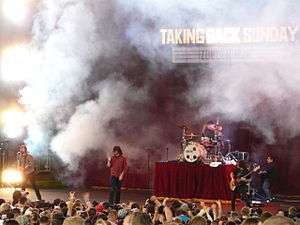

In the wake of this success, many emo bands were signed to major record labels and the genre became marketable.[124] According to Dreamworks Records senior A&R representative Luke Wood, "The industry really does look at emo as the new rap rock, or the new grunge. I don't think that anyone is listening to the music that's being made—they're thinking of how they're going to take advantage of the sound's popularity at retail."[125] Emo's apolitical nature, catchy music and accessible themes had broad appeal for a young, mainstream audience. Emo bands that emerged or broke into the mainstream during this time were rejected by many fans of older emo music.[107] As emo continued to be mainstream, it became quite common for emo bands to have black hair and wear eyeliner.[107] Taking Back Sunday had continued success in the next few years, with their 2004 album Where You Want To Be both reaching number three on the Billboard 200 and being certified gold by the RIAA in July 2005.[126] The album, as of February 17, 2006, sold more than 700,000 copies in the United States, according to Nielsen SoundScan.[127] Where You Want To Be's second single, "This Photograph is Proof (I Know You Know)", appeared on the Spider-Man 2 soundtrack. The band's 2006 album, Louder Now, reached number two on the Billboard 200, was certified gold by the RIAA a little less than two months after its release date,[128] and, as of May 8, 2009, sold 674,000 copies.[121] The All-American Rejects' self-titled album was certified platinum by the RIAA;[129] "Swing, Swing", a track from the album, reached number 60 on the Billboard Hot 100.[130] Their album Move Along was certified double platinum by the RIAA;[131] its single, "Dirty Little Secret", reached number nine on the Billboard Hot 100[130] and was certified platinum by the RIAA.[132] Canadian emo band Simple Plan's 2002 album, No Pads, No Helmets...Just Balls was certified double platinum by the RIAA[133] and Music Canada;[134] their 2004 album, Still Not Getting Any..., was certified platinum by the RIAA[135] and quadruple platinum by Music Canada.[136] Hawthorne Heights' 2004 album The Silence in Black and White sold 929,000 copies in the United States[137] and the album's song "Ohio Is for Lovers" has been described as "the emo anthem".[138] Hawthorne Heights' 2006 album If Only You Were Lonely sold 114,000 copies in its first week of being released.[139] In November 2007, Hawthorne Heights guitarist Casey Calvert died at the age of 25 years old.[140][141]
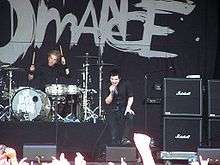

Other emo bands which achieved mainstream success during the 2000s included My Chemical Romance, Fall Out Boy, AFI, Relient K, Plain White T's, The Red Jumpsuit Apparatus, Boys Like Girls, Panic! at the Disco and Paramore. My Chemical Romance broke into the mainstream with their 2004 album Three Cheers for Sweet Revenge. My Chemical Romance is known for their goth-influenced emo appearance and creation of concept albums and rock operas.[142][143] Three Cheers for Sweet Revenge was certified platinum by the RIAA in 2005.[144] The band's success continued with its third album, The Black Parade, which sold 240,000 copies in its first week of release[145] and was certified platinum by the RIAA in less than a year.[146] Fall Out Boy's album, From Under the Cork Tree, sold 2,700,000 copies in the United States.[147] The band's album, Infinity on High, topped the Billboard 200, sold 260,000 copies in its first week of release[148] and sold 1,400,000 copies in the United States.[147] "Sugar, We're Goin' Down" reached number eight on the Billboard Hot 100,[149] and "Dance, Dance" reached number nine on the chart.[149] Also, Fall Out Boy's song "Thnks fr th Mmrs" went to number 11 on the Billboard Hot 100.[149] Panic! at the Disco's album, A Fever You Can't Sweat Out, was certified double platinum by the RIAA;[150] its single, "I Write Sins Not Tragedies", reached number seven on the Billboard Hot 100[151] and was certified quadruple platinum by the RIAA.[152] Panic! at the Disco are known for combining emo with electronics[153] and their album A Fever You Can't Sweat Out is an emo album[154] with elements of dance-punk[155] and baroque pop.[156] The Red Jumpsuit Apparatus' "Face Down" peaked at number 24 on the Billboard Hot 100[157] and its album, Don't You Fake It, sold 852,000 copies in the United States.[158] AFI's albums Sing the Sorrow and Decemberunderground both were certified platinum by the RIAA,[159][160] with Decemberunderground peaking at number 1 the Billboard 200.[161] AFI's song "Miss Murder" peaked at number 24 on the Billboard Hot 100 on June 24, 2006. AFI's song "Love Like Winter" peaked at number 68 on the Billboard Hot 100 on January 13, 2007.[162]
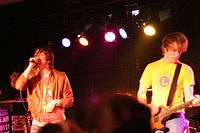

Relient K's songs "Who I Am Hates Who I've Been" and "Be My Escape" peaked at number 58 on the Billboard Hot 100 in 2006 and number 82 on the Billboard Hot 100 in 2005, respectively.[163] "Who I Am Hates Who I've Been" and "Be My Escape" were certified gold by the RIAA in February 2006 and October 2005, respectively.[164][165] Relient K's 2004 album Mmhmm was certified gold by the RIAA on July 15, 2005.[166] Relient K's 2003 album Two Lefts Don't Make a Right...but Three Do was certified gold by the RIAA on March 21, 2005.[167] Relient K's 2001 album The Anatomy of the Tongue in Cheek was certified gold by the RIAA on June 26, 2006.[168] Plain White T's broke into the mainstream with their 2006 album Every Second Counts. Released on September 12, 2006, Every Second Counts was certified gold by the RIAA on July 3, 2007.[169] Four Plain White T's songs were on the Billboard Hot 100 chart during the 2000s, including the song "Hey There Delilah" which peaked at number 1 on the chart on July 28, 2007.[170] Paramore's 2007 album Riot! was certified double platinum by the RIAA;[171] their song, "Misery Business", peaked at number 26 on the Billboard Hot 100[172] and was certified triple platinum by the RIAA.[173] Several other Paramore songs appeared on the Billboard Hot 100 in the late 2000s, including "Decode", "Crushcrushcrush", "That's What You Get", and "Ignorance".[172] Emo band Boys Like Girls achieved mainstream success in the late 2000s. The band's first hit "The Great Escape" peaked at number 23 on the Billboard Hot 100 in September 2007. Their song "Love Drunk" peaked at number 22 on the Billboard Hot 100 in July 2009.[174] "The Great Escape" and "Love Drunk" both peaked at number 8 on the Mainstream Top 40 chart in September 2007 and October 2009, respectively.[175] Both "The Great Escape" and "Love Drunk" were certified platinum by the RIAA.[176][177]

A darker, more aggressive style of emo was also becoming popular. New Jersey–based Thursday signed a multimillion-dollar, multi-album contract with Island Def Jam after their 2001 album, Full Collapse, reached umber 178 on the Billboard 200.[178] Their music was more political and lacked pop hooks and anthems, influenced instead by The Smiths, Joy Division, and The Cure However, the band's accessibility, basement-show roots and touring with Saves the Day made them part of the emo movement.[179] Thursday's 2003 album, War All the Time, reached number seven on the Billboard 200.[180] Hawthorne Heights, Story of the Year, Underoath, and Alexisonfire, four bands frequently featured on MTV, have popularized screamo.[181] Other screamo bands include Silverstein,[182] Senses Fail[183][184] and Vendetta Red.[181] Underoath's albums They're Only Chasing Safety (2004)[185] and Define the Great Line (2006)[186] both were certified gold by the RIAA. The Used's self-titled album (2002) was certified gold by the RIAA on July 21, 2003.[187] The Used's self-titled album, as of August 22, 2009, has sold 841,000 copies.[188] The Used's album In Love and Death (2004) was certified gold by the RIAA on March 21, 2005.[189] In Love and Death, as of January 2, 2007, sold 689,000 copies in the United States, according to Nielsen SoundScan.[190] The Used's album Lies for the Liars (2007) sold 322,000 copies, according to Nielsen SoundScan.[188] The Used's song "The Bird and the Worm" peaked at number 7 on the Bubbling Under Hot 100 chart on June 23, 2007.[191] On July 7, 2007, "The Bird and the Worm" peaked at number 9 on the Alternative Songs chart.[192] Four Alexisonfire albums were certified gold or platinum in Canada.[193][194][195][196]
2010s: Decline and mainly underground revival
During the mid 2010s, emo's popularity began to wane. Some bands broke up or moved away from their emo roots;[197] According to a vice article some Emos grew up to be K-Pop fans.[198] My Chemical Romance's album, Danger Days: The True Lives of the Fabulous Killjoys, has a traditional pop punk style.[199] Paramore and Fall Out Boy both abandoned the emo genre with their 2013 albums, Paramore and Save Rock and Roll, respectively.[200][201][202] Paramore moved to a new wave-influenced style.[203] Panic! at the Disco moved away from their emo pop roots to a synth-pop style on Too Weird to Live, Too Rare to Die!.[204] Many bands (including My Chemical Romance,[205] Alexisonfire,[206] and Thursday)[207] broke up, raising concerns about the genre's viability.[208]
Meanwhile, by the 2010s, a mainly underground emo revival emerged,[209][210][211] drawing on the sound and aesthetic of 1990s emo. Artists associated with this movement include Modern Baseball,[212] The World Is a Beautiful Place & I Am No Longer Afraid to Die,[209][211][213] A Great Big Pile of Leaves,[209] Pianos Become the Teeth,[211] Empire! Empire! (I Was a Lonely Estate),[209] Touché Amoré,[209][213] Into It. Over It.,[209][213] and the Hotelier.[214] While many 2010s emo bands draw on the sound and aesthetic of 1990s emo, hardcore punk elements are consistently used by 2010s emo bands such as Title Fight[215] and Small Brown Bike.[216]
Subgenres and fusion genres
Subgenres
Emo pop
Emo pop (or emo pop punk) is a subgenre of emo that for its pop music influences, more concise songs and hook-filled choruses.[99] AllMusic describes emo pop as blending "youthful angst" with "slick production" and mainstream appeal, using "high-pitched melodies, rhythmic guitars, and lyrics concerning adolescence, relationships, and heartbreak."[99] The Guardian described emo pop as a cross between "saccharine boy-band pop" and emo.[217]
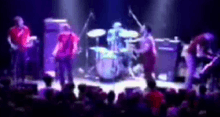

Emo pop developed during the 1990s. Bands like Jawbreaker and Samiam are known for formulating the emo pop punk style.[218] According to Nicole Keiper of CMJ New Music Monthly, Sense Field's Building (1996) pushed the band "into the emo-pop camp with the likes of the Get Up Kids and Jejune".[219] As emo became commercially successful in the early 2000s, emo pop became popular with Jimmy Eat World's 2001 album Bleed American and the success of its single "The Middle".[99] Jimmy Eat World,[99] the Get Up Kids[220] and the Promise Ring[221] also are early emo pop bands. The emo pop style of Jimmy Eat World's album, Clarity[222] influenced later emo.[223] The emo band Braid's 1998 album Frame & Canvas has been described as emo pop by Blake Butler of AllMusic, who gave the Braid album four out of five stars and wrote that Frame & Canvas "proves to be one of Braid's best efforts".[224] Emo pop became successful during the late 1990s, with its popularity increasing in the early 2000s. The Get Up Kids sold over 15,000 copies of their debut album, Four Minute Mile (1997), before signing with Vagrant Records. The label promoted them, sending them on tours to open for Green Day and Weezer.[89] Their 1999 album, Something to Write Home About, reached number 31 on Billboard's Top Heatseekers chart.[90] As of May 2, 2002, Something to Write Home About sold 134,000 copies in the United States, according to Nielsen SoundScan.
As emo pop coalesced, the Fueled by Ramen label became a center of the movement and signed Fall Out Boy, Panic! at the Disco, and Paramore (all of whom had been successful).[99] Two regional scenes developed. The Florida scene was created by Fueled by Ramen; midwest emo-pop was promoted by Pete Wentz, whose Fall Out Boy rose to the forefront of the style during the mid-2000s.[99][225][226] Cash Cash released Take It to the Floor (2008); according to AllMusic, it could be "the definitive statement of airheaded, glittery, and content-free emo-pop[227] ... the transformation of emo from the expression of intensely felt, ripped-from-the-throat feelings played by bands directly influenced by post-punk and hardcore to mall-friendly Day-Glo pop played by kids who look about as authentic as the "punks" on an old episode of Quincy did back in the '70s was made pretty much complete".[227] You Me at Six released their 2008 debut album, Take Off Your Colours, described by AllMusic's Jon O'Brien as "follow[ing] the 'emo-pop for dummies' handbook word-for-word."[228] The album was certified gold in the UK.[229]
Screamo
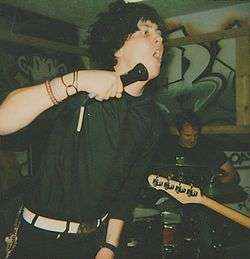
The term "screamo" was initially applied to an aggressive offshoot of emo which developed in San Diego in 1991 and used short songs grafting "spastic intensity to willfully experimental dissonance and dynamics."[230] Screamo is a dissonant form of emo influenced by hardcore punk,[181] with typical rock instrumentation and noted for short songs, chaotic execution and screaming vocals.

The genre is "generally based in the aggressive side of the overarching punk-revival scene."[181] It began at the Ché Café[232] with groups such as Heroin, Antioch Arrow,[233] Angel Hair, Mohinder, Swing Kids, and Portraits of Past.[234] They were influenced by Washington, D.C. post-hardcore (particularly Fugazi and Nation of Ulysses),[230] straight edge, the Chicago group Articles of Faith, the hardcore-punk band Die Kreuzen[235] and the post-punk and gothic rock bands like Bauhaus.[230] I Hate Myself is a band described as "a cornerstone of the 'screamo' genre" by author Matt Walker:[236] "Musically, I Hate Myself relied on being very slow and deliberate, with sharp contrasts between quiet, almost meditative segments that rip into loud and heavy portions driven by Jim Marburger's tidal wave scream."[237] Other early screamo bands include Pg. 99, Saetia, and Orchid.[238]
The Used, Thursday, Thrice and Poison the Well, who all formed in the United States during the late 1990s and early 2000s and remained active throughout the 2000s, helped popularize screamo.[181] Post-hardcore bands such as Refused and At the Drive-In paved the way for these bands.[181] Screamo bands from the Canadian emo scene such as Silverstein[239] and Alexisonfire[240] also emerged at this time. By the mid-2000s, the saturation of the screamo scene caused many bands to expand beyond the genre and incorporate more-experimental elements.[181] Non-screamo bands used the genre's characteristic guttural vocal style.[181]
Jeff Mitchell of the Iowa State Daily wrote, "There is no set definition of what screamo sounds like but screaming over once deafeningly loud rocking noise and suddenly quiet, melodic guitar lines is a theme commonly affiliated with the genre."[241]
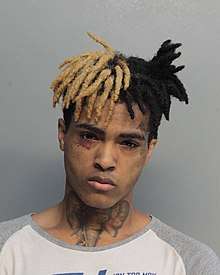
Fusion genres
Emo rap
Emo rap is a genre that combines emo music with hip hop music.[243] The genre began in the mid–late 2010s.[243] Although emo rap typically uses regular instruments and sampling is often kept to a bare minimum, some artists sample 2000s pop punk and emo songs, a fusion first popularized by MC Lars in 2004.[244][245] A lot of the sampling is due to the artists who inspired the genre, such as Underoath and Brand New,[246] and is usually accompanied by original instruments. Prominent artists of emo hip hop include Lil Peep,[247] XXXTentacion,[243] and nothing,nowhere.[248][249]
In the mid-to-late 2010s, emo rap broke into the mainstream. Deceased rapper XXXTentacion's song "Sad!" peaked at number 1 on the Billboard Hot 100 on June 30, 2018. XXXTentacion also had other mainstream songs. His song "Moonlight" peaked at number 13 on the Billboard Hot 100 on July 7, 2018, his song "Changes" peaked at number 18 on the Billboard Hot 100 on June 30, 2018, and his song "Jocelyn Flores" peaked at number 19 on June 30, 2018.[250] Emo rap musician Lil Uzi Vert's song "XO Tour Llif3" peaked at number 7 on the Billboard Hot 100[251] and the song was certified 6x platinum by the RIAA.[252] Although emo rap experienced much mainstream popularity during the mid-to-late 2010s, emo rap musicians Lil Peep and XXXTentacion both died in November 2017 and June 2018, respectively. In November 2017, Lil Peep died of a Fentanyl and Xanax overdose.[253] In June 2018, XXXTentacion was shot and murdered in Florida.[254]
Fashion and subculture

Emo fashion was originally clean-cut and tended towards geek chic.[255] A January 2002 Honolulu Advertiser article compared the style to Fred Rogers', noting differences between emo and goth or hip-hop styles: V-neck sweaters, white dress shirts and fitted, cuffed jeans.[255] The Advertiser described emo fashion as sweaters, tight shirts, horn-rimmed glasses (like those worn by Buddy Holly), dyed black hair and fitted, flat-front jeans.[255]
As emo entered the mainstream, it became a subculture.[256] Emo fashion included skinny jeans, tight T-shirts (usually short-sleeved, and often with the names of emo bands), studded belts, Converse sneakers, Vans and black wristbands.[257][258] Thick, horn-rimmed glasses remained in style,[257] and eyeliner and black fingernails became common during the mid-2000s.[256][259] Emo tattoos are stars, hearts and notes, on the back, upper arms and across the chest.[260] The best-known facet of emo fashion is its hairstyle: flat, straight, usually jet-black hair with long bangs covering much of the face,[258] which has been called a fad.[258] Emo fashion has been confused with goth[261] and scene fashion.[262]
As emo became a subculture, people who dressed in emo fashion and associated themselves with its music were known as "emo kids" or "emos".[258] My Chemical Romance,[258][259] Hawthorne Heights,[258] AFI,[258] Dashboard Confessional,[263] Taking Back Sunday,[264] Good Charlotte,[265] Brand New, From First to Last,[266] Bullet for My Valentine,[267] Story of the Year,[268] Funeral for a Friend,[269] Silverstein,[270] Simple Plan,[271] Aiden,[256] Fall Out Boy,[258][272] The Used,[256] Finch,[256] Panic! at the Disco[271] and Paramore[271] all are bands that emos are known for listening to.
Criticism and controversy
Stereotypes
Emo has been associated with a stereotype of emotion, sensitivity, shyness, introversion or angst.[11][273][274] Other stereotypes include depression, self-harm and suicide.[258][275] Some people explained the difference between emos and goths by saying that "emos hate themselves, while goths hate everyone."[276]
Suicide and self harm
Emo music was blamed for the suicide by hanging of teenager Hannah Bond by the coroner at her inquest and her mother, Heather Bond, with emo music reportedly glamorizing suicide; Hannah's apparent obsession with My Chemical Romance was said to be linked to her death. It was said at the inquest that she was part of an Internet "emo cult", and an image of an emo girl with bloody wrists was on her Bebo page.[277] Hannah reportedly told her parents that her self-harm was an "emo initiation ceremony".[277] Heather Bond criticised emo culture: "There are 'emo' websites that show pink teddies hanging themselves."[277] After the coroner's verdict was reported in NME, fans of emo music contacted the magazine to deny that it promoted self-harm and suicide.[278] My Chemical Romance reacted online to the suicide of Hannah Bond: "We have recently learned of the suicide and tragic loss of Hannah Bond. We'd like to send our condolences to her family during this time of mourning. Our hearts and thoughts are with them".[279] The band also posted that they "are and always have been vocally anti-violence and anti-suicide".[279]
Qualitative research has shown emo respondents reported “attitudes including high acceptance for suicidal behavior and self-injury”. The authors concluded: "The identification with the emo youth subculture is considered to be a factor strengthening vulnerability towards risky behaviors."[280]

Backlash
Emo received a lot of backlash during the 2000s. Some emo bands, such as Panic! at the Disco[281] and My Chemical Romance,[282] rejected the emo label for its social stigma and controversy. Warped Tour founder Kevin Lyman said that there was a "real backlash" by bands on the tour against emo groups, but he dismissed the hostility as "juvenile".[283] The backlash intensified, with anti-emo groups attacking teenagers in Mexico City, Querétaro, and Tijuana in 2008.[284][285] Legislation was proposed in Russia's Duma regulating emo websites and banning emo attire in schools and government buildings, with the subculture perceived as a "dangerous teen trend" promoting anti-social behaviour, depression, social withdrawal and suicide.[286][287] The BBC reported that in March 2012, Shia militias in Iraq shot or beat to death as many as 58 young Iraqi emos.[288] Metalheads and punks often were known for hating emos and criticizing the emo subculture.[289]
See also
References
Citations
- "Emo". AllMusic.
- Bryant 2014, p. 134.
- Cooper, Ryan. "Post-Hardcore – A Definition". About.com. Archived from the original on March 4, 2016. Retrieved July 12, 2016.
all emo is post-hardcore, but not all post-hardcore is emo.
- Hansen 2009.
- Shuker 2017.
- Green, Stuart (January 1, 2006). "The Get Up Kids...It's A Whole New Emo". Exclaim!. Retrieved July 21, 2018.
- Crane, Matt (April 17, 2014). "The 5 great eras of pop-punk, from the '70s to today". Alternative Press.
- Kuipers, Dean (July 7, 2002). "Oh the Angst. Oh the Sales". Los Angeles Times.
- Diehl 2013, p. 82.
- Cooper, Ryan. "The Subgenres of Punk Rock". ThoughtCo. Retrieved August 9, 2018.
- La Gorce, Tammy (August 14, 2007). "Finding Emo". The New York Times. Retrieved October 20, 2007.
- "Emo". Merriam-Webster. Retrieved January 5, 2017.
- Britton, Luke Morgan (May 30, 2018). "Emo never dies: How the genre influenced an entire new generation". BBC Online. Retrieved August 9, 2018.
- "Post-Hardcore". AllMusic.
- Greenwald 2003, p. 12.
- "Rites of Spring | Biography". AllMusic.
- Greenwald 2003, pp. 9–11.
- Blush 2001, p. 157.
- Greenwald 2003, pp. 12–13.
- Greenwald 2003, p. 13.
- Greenwald 2003, p. 14.
- Azerrad 2001, p. 380.
- Khanna, Vish (February 2007). "Timeline: Ian MacKaye – Out of Step". Exclaim.ca. Archived from the original on January 10, 2013. Retrieved April 19, 2009.
- DePasquale, Ron. "Embrace: Biography". AllMusic. Retrieved April 21, 2009.
- Popkin, Helen (March 26, 2006). "What Exactly Is 'Emo,' Anyway?". Today.com. Today.com. Retrieved April 21, 2009.
- Greenwald 2003, pp. 14–15.
- Greenwald 2003, p. 15.
- Greenwald 2003, pp. 15–17.
- Greenwald 2003, pp. 15–16.
- Greenwald 2003, p. 18.
- Greenwald 2003, p. 19.
- Etc (CD booklet). Jawbreaker. San Francisco: Blackball Records. 2002. BB-003-CD.CS1 maint: others (link)
- Greenwald 2003, p. 21.
- Greenwald 2003, p. 20.
- Monger, James Christopher. "Jawbreaker | Biography & History". AllMusic.
- Greenwald 2003, pp. 21–22.
- Greenwald 2003, pp. 24–25.
- Greenwald 2003, pp. 25–26.
- Greenwald 2003, p. 28.
- Greenwald 2003, p. 29–31.
- Smith, Rich (June 1, 2016). "A Grown-Up Emo Kid Braces for the Coming Wave of Emo Nostalgia". The Stranger. Retrieved July 21, 2018.
- Ayers, Michael D. (August 21, 2009). "Weezer Filled With 'Raditude' This Fall". Billboard. Prometheus Global Media.
- Mackay, Emily (November 2, 2009). "Album review: Weezer – 'Raditude'". NME.
- Book Your Own Fuckin' Life #3: Do-It-Yourself Resource Guide. San Francisco, CA: Maximum Rocknroll, 1994; pg. 3.
- Leahey, Andrew. "Jimmy Eat World | Biography & History". AllMusic.
- Greenwald 2003, p. 33.
- "American album certifications – Green Day – Dookie". Recording Industry Association of America. If necessary, click Advanced, then click Format, then select Album, then click SEARCH.
- "American album certifications – Offspring – Smash". Recording Industry Association of America. If necessary, click Advanced, then click Format, then select Album, then click SEARCH.
- Greenwald 2003, pp. 34–35.
- Greenwald 2003, p. 34.
- Galil, Leor (August 5, 2013). "Midwestern emo catches its second wind". The Chicago Reader. Retrieved July 5, 2017.
- Greenwald 2003, pp. 38–39.
- Greenwald 2003, pp. 121–122.
- Greenwald 2003, p. 122.
- Rashbaum, Alyssa (March 24, 2006). "A Lifetime of Rock". Spin. Retrieved March 28, 2009.
- Greenwald 2003, p. 80.
- Greenwald 2003, p. 152.
- Greenwald 2003, p. 51.
- Greenwald 2003, pp. 35–36.
- Greenwald 2003, p. 36.
- Greenwald 2003, p. 37.
- Greenwald 2003, p. 40.
- Edwards, Gavin (December 9, 2001). "Review: Pinkerton". Rolling Stone. Archived from the original on October 5, 2006. Retrieved March 23, 2009.
- Erlewine, Stephen. "Allmusic: Pinkerton: Overview". AllMusic. Retrieved September 21, 2007.
- Greenwald 2003, p. 50.
- Luerssen 2004, p. 206.
- Luerrsen 2004, p. 137.
- Luerrsen 2004, p. 348.
- Montgomery, James (October 25, 2004). "The Argument: Weezer Are the Most Important Band of the Last 10 Years". MTV. Retrieved March 23, 2009.
- "American album certifications – Weezer – Pinkerton". Recording Industry Association of America. If necessary, click Advanced, then click Format, then select Album, then click SEARCH.
- Greenwald 2003, p. 41.
- Greenwald 2003, pp. 46–48.
- Greenwald, pp. 42–44.
- Greenwald 2003, p. 42.
- Greenwald 2003, pp. 45–46.
- Greenwald 2003, pp. 99–101.
- Greenwald 2003, p. 44.
- Greenwald 2003, p. 48.
- "The Emo Diaries". Deep Elm Records. Retrieved March 27, 2009.
- Greenwald 2003, p. 101.
- Vanderhoff, Mark. "Clarity - Jimmy Eat World". AllMusic. Retrieved March 26, 2009.
- Greenwald 2003, pp. 102–205.
- Greenwald 2003, pp. 104–108.
- Greenwald 2003, pp. 126–132.
- Greenwald 2003, p. 127.
- "Artist Chart History – New Found Glory: Albums". Billboard charts. Retrieved March 31, 2009.
- "Artist Chart History – New Found Glory: Singles". Billboard charts. Retrieved March 31, 2009.
- Greenwald 2003, pp. 127–129.
- Greenwald 2003, pp. 77–78.
- "Heatseekers: Something to Write Home About". Billboard charts. Archived from the original on June 10, 2009. Retrieved March 25, 2009.
- Greenwald 2003, p. 79.
- Greenwald 2003, p. 81.
- "Artist Chart History – Saves the Day". Billboard charts. Retrieved March 26, 2009.
- Sheffield, Rob (March 28, 2002). "Punk From the Heart". Rolling Stone. Archived from the original on March 5, 2004. Retrieved August 28, 2015.
- Bein, Kat (July 12, 2016). "Blink-182 Songs: List of the 7 Best Remixes". Billboard. Retrieved August 2, 2018.
- "American album certifications – Blink-182 – Enema of the State". Recording Industry Association of America. If necessary, click Advanced, then click Format, then select Album, then click SEARCH.
- "blink-182 Chart History (Alternative Songs)". Billboard. Retrieved August 2, 2018.
- Greenwald 2003, pp. 81–88.
- "Emo-Pop". AllMusic. Retrieved June 10, 2011.
- Greenwald 2003, p. 52.
- "American album certifications – Weezer – Weezer (2001)". Recording Industry Association of America. If necessary, click Advanced, then click Format, then select Album, then click SEARCH.
- Greenwald 2003, p. 68.
- "Jimmy Eat World singles chart history". Billboard charts. Retrieved March 23, 2009.
- "Dashboard Confessional albums chart history". Billboard charts. Retrieved March 23, 2009.
- "Emo-esque, huh?". News24. July 26, 2002. Retrieved August 11, 2018.
- Greenwald 2003, p. 94.
- Connick, Tom (April 30, 2018). "The beginner's guide to the evolution of emo". NME. Retrieved August 12, 2018.
- "American album certifications – Weezer – Maladroit". Recording Industry Association of America. If necessary, click Advanced, then click Format, then select Album, then click SEARCH.
- Leahey, Andrew. "Dashboard Confessional | Biography & History". AllMusic. Retrieved October 20, 2017.
- Greenwald 2003, p. 196.
- "Gold & Platinum (Dashboard Confessional)". Recording Industry Association of America. Retrieved August 11, 2018.
- DeRogatis, Jim (October 3, 2003). "True Confessional?". Retrieved August 15, 2018.
- Caulfield, Keith (October 19, 2007). "Ask Billboard". Billboard. Retrieved August 11, 2018.
- "Dashboard Confessional Chart History (Hot 100)". Billboard. Retrieved August 11, 2018.
- "New Found Glory albums chart history". Billboard. Retrieved March 23, 2009.
- "The Get Up Kids | Awards". AllMusic.
- Sanneh, Kelefa (August 10, 2003). "Music; Sweet, Sentimental and Punk". The New York Times. Retrieved August 12, 2018.
- Greenwald 2003, p. 67.
- Wilson, MacKenzie. "Saves the Day Biography". AllMusic. Retrieved March 26, 2009.
- "American album certifications – Taking Back Sunday – Tell All Your Friends". Recording Industry Association of America. If necessary, click Advanced, then click Format, then select Album, then click SEARCH.
- Wood, Mikael (May 8, 2009). "Exclusive Video: Taking Back Sunday's Latest Epic". Billboard. Retrieved August 11, 2018.
- Greenwald 2003, p. 88.
- Greenwald 2003, pp. 68–69.
- Greenwald 2003, pp. 140–141.
- Greenwald 2003, p. 142.
- "American album certifications – Taking Back Sunday – Where You Want To Be". Recording Industry Association of America. If necessary, click Advanced, then click Format, then select Album, then click SEARCH.
- "Taking Back Sunday Plans Spring U.S. Tour". Billboard. February 17, 2006. Retrieved August 11, 2018.
- "American album certifications – Taking Back Sunday – Louder Now". Recording Industry Association of America. If necessary, click Advanced, then click Format, then select Album, then click SEARCH.
- "American album certifications – The All-American Rejects – The All-American Rejects". Recording Industry Association of America. If necessary, click Advanced, then click Format, then select Album, then click SEARCH.
- "The All-American Rejects - Chart history". Billboard.
- "American album certifications – The All-American Rejects – Move Along". Recording Industry Association of America. If necessary, click Advanced, then click Format, then select Album, then click SEARCH.
- "American single certifications – The All-American Rejects – Dirty Little Secret". Recording Industry Association of America. If necessary, click Advanced, then click Format, then select Single, then click SEARCH.
- "American album certifications – Simple Plan – No Pads, No Helmets...Just Balls". Recording Industry Association of America. If necessary, click Advanced, then click Format, then select Album, then click SEARCH.
- "Canadian album certifications – Simple Plan – No Pads, No Helmets...Just Balls". Music Canada.
- "American album certifications – Simple Plan – Still Not Getting Any..." Recording Industry Association of America. If necessary, click Advanced, then click Format, then select Album, then click SEARCH.
- "Canadian album certifications – Simple Plan – Still Not Getting Any..." Music Canada.
- Cohen, Jonathan (February 2, 2009). "Hawthorne Heights Goes All In With Wind-Up". Billboard. Retrieved May 16, 2017.
- Chapman, Joseph (February 2, 2011). "Q&A: JT Woodruff of Hawthorne Heights". The Daily Tar Heel. Retrieved August 12, 2018.
- Harris, Chris (March 8, 2006). "Ne-Yo Rises Above Hawthorne Heights With A Landslide Billboard Win". MTV. Retrieved May 16, 2017.
- Labbé, Theola (November 26, 2007). "Guitarist Found Dead Before Show in D.C." The Washington Post. Retrieved August 12, 2018.
- Cohen, Jonathan (November 26, 2007). "Hawthorne Heights Guitarist Calvert Found Dead". Billboard. Retrieved August 12, 2018.
- Spanos, Brittany (July 21, 2016). "My Chemical Romance Plots 'Black Parade' Reissue for 10th Anniversary". Rolling Stone. Retrieved August 12, 2018.
- Leahey, Andrew. "My Chemical Romance | Biography & History". AllMusic. Retrieved August 12, 2018.
- "American album certifications – My Chemical Romance – Three Cheers for Sweet Revenge". Recording Industry Association of America. If necessary, click Advanced, then click Format, then select Album, then click SEARCH.
- Harris, Chris (November 1, 2006). "Hannah Montana Rains On My Chemical Romance's Parade". MTV.
- "American album certifications – My Chemical Romance – The Black Parade". Recording Industry Association of America. If necessary, click Advanced, then click Format, then select Album, then click SEARCH.
- "Fall Out Boy to 'Save Rock and Roll' in May". Billboard. February 4, 2013.
- Hasty, Katie (February 14, 2007). "Fall Out Boy Hits 'High' Note With No. 1 Debut". Billboard.
- "Fall Out Boy – Chart History". Billboard.
- "American album certifications – Panic! at the Disco – A Fever You Can't Sweat Out". Recording Industry Association of America. If necessary, click Advanced, then click Format, then select Album, then click SEARCH.
- "Panic! at the Disco – Chart History". Billboard.
- "American single certifications – Panic! at the Disco – I Write Sins Not Tragedies". Recording Industry Association of America. If necessary, click Advanced, then click Format, then select Single, then click SEARCH.
- Galil, Leor (July 14, 2009). "Scrunk happens". The Phoenix. Archived from the original on August 19, 2009. Retrieved August 12, 2018.
- Bayer, Jonah; Burgess, Aaron; Exposito, Suzy; Galil, Leor; Montgomery, James; Spanos, Brittany (March 1, 2016). "40 Greatest Emo Albums of All Time". Rolling Stone. Retrieved August 12, 2018.
- Zemler, Emily (October 3, 2005). "Panic! at the Disco". Spin. Retrieved August 12, 2018.
- Story, Hannah (January 11, 2016). "Panic! At The Disco - Death Of A Bachelor". The Music. Retrieved August 12, 2018.
- "The Red Jumpsuit Apparatus | Awards". AllMusic.
- Cohen, Jonathan (August 18, 2008). "Red Jumpsuit Apparatus Recording New Album". Billboard.
- "American album certifications – AFI – Sing the Sorrow". Recording Industry Association of America. If necessary, click Advanced, then click Format, then select Album, then click SEARCH.
- "American album certifications – AFI – Decemberunderground". Recording Industry Association of America. If necessary, click Advanced, then click Format, then select Album, then click SEARCH.
- "AFI Burns Brightly With No. 1 Debut". Billboard. June 14, 2006.
- "AFI Chart History". Billboard. Retrieved August 11, 2018.
- "Relient K Chart History". Billboard. Retrieved August 12, 2018.
- "American single certifications – Relient K – Who I Am Hates Who I've Been". Recording Industry Association of America. If necessary, click Advanced, then click Format, then select Single, then click SEARCH.
- "American single certifications – Relient K – Be My Escape". Recording Industry Association of America. If necessary, click Advanced, then click Format, then select Single, then click SEARCH.
- "American album certifications – Relient K – Mmhmm". Recording Industry Association of America. If necessary, click Advanced, then click Format, then select Album, then click SEARCH.
- "American album certifications – Relient K – Two Lefts Don't Make a Right...but Three Do". Recording Industry Association of America. If necessary, click Advanced, then click Format, then select Album, then click SEARCH.
- "American album certifications – Relient K – The Anatomy of the Tongue in Cheek". Recording Industry Association of America. If necessary, click Advanced, then click Format, then select Album, then click SEARCH.
- "American album certifications – Plain White T's – Every Second Counts". Recording Industry Association of America. If necessary, click Advanced, then click Format, then select Album, then click SEARCH.
- "Plain White T's Chart History". Billboard. Retrieved August 12, 2018.
- "American album certifications – Paramore – Riot!". Recording Industry Association of America. If necessary, click Advanced, then click Format, then select Album, then click SEARCH.
- "Paramore – Chart history". Billboard.
- "American single certifications – Paramore – Misery Business". Recording Industry Association of America. If necessary, click Advanced, then click Format, then select Single, then click SEARCH.
- "Boys Like Girls Chart History (Hot 100)". Billboard. Retrieved December 21, 2019.
- "Boys Like Girls Chart History (Mainstream Top 40)". Billboard. Retrieved December 21, 2019.
- "American single certifications – Boys Like Girls – The Great Escape". Recording Industry Association of America. If necessary, click Advanced, then click Format, then select Single, then click SEARCH.
- "American single certifications – Boys Like Girls – Love Drunk". Recording Industry Association of America. If necessary, click Advanced, then click Format, then select Single, then click SEARCH.
- Greenwald 2003, pp. 149–150.
- Greenwald 2003, pp. 153–155.
- "Artist Chart History - Thursday - Albums" Billboard.
- Explore style: Screamo at AllMusic Music Guide
- Lake, Dave (December 2, 2015). "Senses Fail Singer Buddy Nielsen Blames Apathy for Breeding "Garbage Like Donald Trump"". New Times Broward-Palm Beach. Retrieved July 21, 2018.
- Alex Henderson. "Let It Enfold You". AllMusic. Retrieved December 9, 2011.
- Andrew Leahey. "Life Is Not a Waiting Room". AllMusic. Retrieved December 9, 2011.
- "American album certifications – Underoath – They're Only Chasing Safety". Recording Industry Association of America. If necessary, click Advanced, then click Format, then select Album, then click SEARCH.
- "American album certifications – Underoath – Define the Great Line". Recording Industry Association of America. If necessary, click Advanced, then click Format, then select Album, then click SEARCH.
- "American album certifications – The Used – The Used". Recording Industry Association of America. If necessary, click Advanced, then click Format, then select Album, then click SEARCH.
- Leebove, Laura (August 22, 2009). "Guitar Heroes". Vol. 121 no. 33. Nielsen Business Media, Inc. p. 31. ISSN 0006-2510. Cite magazine requires
|magazine=(help) - "American album certifications – The Used – In Love and Death". Recording Industry Association of America. If necessary, click Advanced, then click Format, then select Album, then click SEARCH.
- Cohen, Jonathan (January 2, 2007). "Live CD/DVD To Precede New Used Album". Billboard. Retrieved August 11, 2018.
- "Chart Search (The Used)". Billboard. Retrieved August 11, 2018.
- "The Used Chart History (Alternative Songs)". Billboard. Retrieved August 11, 2018.
- "Canadian album certifications – Alexisonfire – Alexisonfire". Music Canada.
- "Canadian album certifications – Alexisonfire – Watch Out!". Music Canada.
- "Canadian album certifications – Alexisonfire – Crisis". Music Canada.
- "Canadian album certifications – Alexisonfire – Old Crows / Young Cardinals". Music Canada.
- "My Chemical Romance Shed Their Emo Roots". Dallas Observer. May 19, 2011.
- "Why So Many Former Emos Are Now K-Pop Fans". Vice. July 29, 2019.
- "My Chemical Romance: Danger Days: The True Lives of the Fabulous Killjoys – review". The Guardian. November 18, 2010.
- Rolli, Bryan (January 22, 2018). "Fall Out Boy's 'MANIA' Proves The Value Of Authenticity". Forbes. Retrieved July 21, 2018.
- Anderson, Kyle (April 10, 2013). "Paramore". Entertainment Weekly. Retrieved July 21, 2018.
- Ben Rayner (April 8, 2013). "Paramore's glossy a bid for superstardom: album review | Toronto Star". Toronto Star. Retrieved July 21, 2018.
- Collar, Matt. "After Laughter - Paramore". AllMusic. Retrieved July 21, 2018.
- "Too Weird to Live, Too Rare to Die! – Panic! at the Disco". AllMusic.
- Kerrang! MCR Split: Gerard Way Confirms Break Up Archived March 28, 2013, at the Wayback Machine. Kerrang.com. Retrieved on 2013-12-12.
- Murphy, Sarah (August 9, 2012). "Alexisonfire Reveal 10 Year Anniversary Farewell Tour". Exclaim!. Retrieved August 9, 2012.
- Rosenbaum, Jason (December 2, 2011). "A Hole in the World: Thursday Calls it Quits". Riverfront Times. Retrieved July 21, 2018.
- "What Happened to Emo?". MTV Hive. April 24, 2013.
- DeVille, Chris (October 2013). "12 Bands To Know From The Emo Revival". Stereogum. Retrieved November 28, 2013.
- Ducker, Eric. "A Rational Conversation: Is Emo Back?". NPR. Retrieved November 28, 2013.
- Cohen, Ian. "Your New Favorite Emo Bands: The Best of Topshelf Records' 2013 Sampler". Pitchfork. Retrieved November 28, 2013.
- Sharp, Tyler (January 7, 2015). "Modern Baseball keep the emo revival alive with "Alpha Kappa Fall Of Troy The Movie Part Deax"". Alternative Press.
- Gormelly, Ian. "Handicapping the Emo Revival: Who's Most Likely to Pierce the Stigma?". Chart Attack. Retrieved November 28, 2013.
- Chatterjee, Kika (July 29, 2017). "18 bands leading the emo revival". Alternative Press.
- Heaney, Gregory. "Title Fight". AllMusic. Retrieved December 12, 2013.
- Zac Johnson. "The River Bed – Small Brown Bike – Songs, Reviews, Credits, Awards – AllMusic". AllMusic.
- Lester, Paul (December 8, 2008). "New band of the day – No 445: Metro Station". The Guardian. Retrieved June 10, 2011.
They peddle "emo-pop", a sort of cross between saccharine boy-band pop and whatever it is that bands like Panic! at the Disco and Fall Out Boy do – emo, let's be frank.
- Catucci, Nick (September 26, 2000). "Emotional Rescue". The Village Voice. Retrieved December 7, 2017.
- Kieper, Nicole (October 2001). "Sense Field: Tonight and Forever – Nettwerk America". CMJ New Music Monthly. CMJ Network. Retrieved June 10, 2011.
- "The Get Up Kids Prep Vinyl Reissues of 'Eudora' and 'On a Wire'".
- "Promise Ring swears by bouncy, power pop". The Michigan Daily. April 12, 2001. Retrieved December 7, 2017.
- "Jimmy Eat World – Clarity – Review". Stylus Magazine. Archived from the original on May 3, 2010.
- Merwin, Charles (August 9, 2007). "Jimmy Eat World > Clarity > Capitol". Stylus. Archived from the original on May 3, 2010. Retrieved May 16, 2010.
- Butler, Brian. "Frame & Canvas - Braid". AllMusic. Retrieved August 14, 2018.
- Loftus, Johnny. "Fall Out Boy". AllMusic. Retrieved June 10, 2011.
- Futterman, Erica. "Fall Out Boy Biography". Rolling Stone. Retrieved June 10, 2011.
- Sendra, Tim. "Take It to the Floor". AllMusic. Retrieved June 11, 2011.
- O'Brien, Jon. "Take Off Your Colours – You Me at Six | Songs, Reviews, Credits". AllMusic. Retrieved December 3, 2015.
- "Archived copy". Archived from the original on June 25, 2014. Retrieved August 29, 2016.CS1 maint: archived copy as title (link)
- Heller, Jason (June 20, 2002). "Feast of Reason". Westword. Retrieved June 15, 2008.
- Brownlee, Bill (August 31, 2016). "Screamo band the Used salvages an affecting debut album on first of two nights at the Midland". The Kansas City Star.
- "A Day with the Locust", L.A. Weekly, September 18, 2003 "Brassland | Home". Archived from the original on March 5, 2009. Retrieved September 14, 2011. Access date: June 19, 2008
- Local Cut, Q&A with Aaron Montaigne. "Archived copy". Archived from the original on July 22, 2011. Retrieved June 10, 2011.CS1 maint: archived copy as title (link) May 14, 2008. Access date: June 11, 2008.
- Ebullition Catalog, Portraits of Past discography. Access date: August 9, 2008.
- "Blood Runs Deep: 23 A hat". Alternative Press. July 7, 2008. p. 126.
- Walker 2016, pp. 102–103.
- Walker 2016, p. 102.
- Ozzi, Dan (August 1, 2018). "The Spirit of Screamo Is Alive and Well". Vice. Retrieved December 21, 2019.
- Adams, Gregory (January 23, 2008). "Silverstein sacrifices for screamo's sake". The Georgia Straight. Retrieved December 7, 2017.
- Usinger, Mike (February 10, 2010). "Punk classics helped reignite Alexisonfire". The Georgia Straight. Retrieved December 7, 2017.
- Mitchell, Jeff (July 26, 2001). "A Screamin' Scene". Iowa State Daily. Retrieved September 11, 2010.
- "XXXTentacion's 2017 XXL Freshman Freestyle and Interview". XXL. June 30, 2017. Retrieved July 21, 2018.
- Zoladz, Lindsay (August 30, 2017). "XXXTentacion, Lil Peep, and the Future of Emo". The Ringer. Retrieved December 5, 2017.
- Vincent, Brittany (October 9, 2017). "Lil Aaron revives meme-tastic dancing goth clip with 'Hot Topic' video". Alternative Press. Retrieved October 16, 2017.
- "MC Lars Sends Up Emo On New Single, Which Stars Fake Band Hearts That Hate". Retrieved January 18, 2018.
- Angus Harrison (April 21, 2017). "Lil Peep: the YouTube rapper who's taking back emo". The Guardian. Retrieved October 16, 2017.
- Hockley-Smith, Sam (August 18, 2017). "The Unappealing World of Lil Peep, Explained". Vulture. Vulture.com. Retrieved September 25, 2017.
- Caramanica, Jon (October 20, 2017). "nothing,nowhere. Blends Hip-Hop and Emo to Make Tomorrow's Pop". The New York Times. Retrieved November 7, 2017.
- Reeves, Mosi (October 31, 2017). "Review: Nothing,Nowhere.'s Tormented Emo-Rap Shows Hip-Hop's Post-Modern Evolution". Rolling Stone. Retrieved November 7, 2017.
- "XXXTentacion Chart History". Billboard. Retrieved July 21, 2018.
- "Lil Uzi Vert Chart History". Billboard. Retrieved July 21, 2018.
- "American single certifications – Lil Uzi Vert – XO Tour Llif3". Recording Industry Association of America. If necessary, click Advanced, then click Format, then select Single, then click SEARCH.
- Britton, Luke Morgan (December 11, 2017). "Lil Peep's cause of death revealed". NME. Retrieved July 21, 2018.
- Snapes, Laura (July 20, 2018). "XXXTentacion: four men charged with rapper's murder". The Guardian. Retrieved July 21, 2018.
- Rath, Paula (January 8, 2002). "Geek chic look is clean cut". The Honolulu Advertiser. Retrieved June 14, 2016.
- Shuster, Yelena (July 17, 2008). "Black Bangs, Piercings Raise Eyebrows in Duma". The Moscow Times.
- Adler & Adler 2011, p. 171.
- Poretta, JP (March 3, 2007). "Cheer up Emo Kid, It's a Brand New Day". The Fairfield Mirror. Archived from the original on March 12, 2007. Retrieved March 8, 2007.
- Thomas-Handsard, Artemis (December 6, 2016). "10 Emo Songs for People Who Don't Know Shit About "Emotional Hardcore"". L.A. Weekly.
- "Emo Tattoo Ideas: Stars, Hearts & More".
- "How are goths and emos defined?". BBC News. April 4, 2013.
- Caroline Marcus "Inside the clash of the teen subcultures" Sydney Morning Herald March 30, 2008
- Mehta, Raghav (January 24, 2017). "A reformed emo kid revisits Dashboard Confessional". City Pages.
- Gassman, Ian (September 15, 2016). "Taking Back Sunday a far cry from emo roots on "Tidal Wave"". The Denver Post.
- Sherman, Maria (December 17, 2015). "The Emo Revival: Why Mall Punk Nostalgia Isn't Fading Away". Fuse.tv.
- Sudakov, Dmitry (December 19, 2006). "Moscow teens develop their own emo-culture, worshipping depression and sadness". Pravda Report. Retrieved August 4, 2018.
- Jaffer, Dave (March 30, 2006). "Bullet For My Valentine - The Poison". Hour Community. Archived from the original on August 4, 2018. Retrieved August 4, 2018.
- Gracie, Bianca (September 27, 2016). "Story of the Year Plans to Drop New Music Next Year". Fuse. Archived from the original on September 28, 2016. Retrieved September 28, 2016.
- "Albums of the week". Metro. May 17, 2007. Retrieved August 4, 2018.
- James, Amber (July 5, 2016). "Fest Review: Amnesia Rockfest Day 1 in Montebello, Quebec". New Noise. Retrieved August 4, 2018.
- Dominguez, Erica (March 24, 2017). "Simple Plan brings the nostalgia during Ft. Lauderdale tour stop". AXS.
- Sawyer 2008, pp. 22–23.
- Bunning, Shane (June 8, 2006). "The attack of the clones: an emo-lution in the fashion industry". Newspace, School of Journalism and Communication, University of Queensland. Archived from the original on August 30, 2007. Retrieved October 20, 2007.
- Stiernberg, Bonnie (March 13, 2007). "What is emo?". The Daily Illini. Archived from the original on October 28, 2007. Retrieved October 20, 2007.
- Walsh, Jeremy (October 18, 2007). "Bayside takes Manhattan". Times Ledger. Archived from the original on October 21, 2007. Retrieved October 20, 2007.
- "About Emo Youth Subculture" (PDF). University of California, Los Angeles.
- "Emo music attacked over teen suicide". NME. May 8, 2008.
- "Emo fans defend their music against suicide claims". NME. May 8, 2008.
- "My Chemical Romance speak about 'emo' suicide". NME. May 25, 2008.
- Trnka, Radek; Kuška, Martin; Balcar, Karel; Tavel, Peter (July 3, 2018). "Understanding death, suicide and self-injury among adherents of the emo youth subculture: A qualitative study". Death Studies. 42 (6): 337–345. doi:10.1080/07481187.2017.1340066. ISSN 0748-1187.
- "Panic! At The Disco declare emo "Bullshit!" The band reject "weak" stereotype". NME. October 18, 2006. Retrieved August 10, 2008.
- "My Chemical Romance brand emo 'shit'". NME. September 20, 2007.
- Diehl 2013, p. 83.
- Grillo, Ioan (March 27, 2008). "Mexico's Emo-Bashing Problem". Time. Retrieved May 12, 2009.
- "Emo kids attacked in Mexico and Chile". NME. March 27, 2008. Retrieved August 2, 2018.
- "Emo to be made illegal in Russia? New laws planned to stop 'dangerous teen trends'". NME. July 23, 2008. Retrieved September 29, 2008.
- Sean Michaels (July 21, 2008). "Russia wages war on emo kids". The Guardian. Retrieved September 29, 2008.
- "Iraqi 'emo' youths reportedly killed by conservative militias". BBC. March 11, 2012. Retrieved March 12, 2012.
- Wells, Steven (April 1, 2008). "The Mexican emocalypse". The Guardian. Retrieved December 21, 2019.
Bibliography
- Adler, Patricia A.; Adler, Peter (2011). The Tender Cut: Inside the Hidden World of Self-Injury. NYU Press. ISBN 9780814705186.CS1 maint: ref=harv (link)
- Azerrad, Michael (2001). Our Band Could Be Your Life: Scenes from the American Indie Underground 1981–1991. New York City, New York, U.S.: Little, Brown and Company. ISBN 978-0-316-78753-6.CS1 maint: ref=harv (link)
- Blush, Steven (2001). American Hardcore: A Tribal History. New York City, New York, U.S.: Feral House. ISBN 978-0-922915-71-2.CS1 maint: ref=harv (link)
- Bryant, Tom (2014). Not the Life It Seems: The True Lives of My Chemical Romance. Da Capo Press. ISBN 978-0-306-82350-3.CS1 maint: ref=harv (link)
- Diehl, Matt (2013). My So-Called Punk: Green Day, Fall Out Boy, The Distillers, Bad Religion---How Neo-Punk Stage-Dived into the Mainstream. St. Martin's Griffin. ISBN 9781466853065.CS1 maint: ref=harv (link)
- Greenwald, Andy (2003). Nothing Feels Good: Punk Rock, Teenagers, and Emo. New York City, New York, U.S.: St. Martin's Griffin. ISBN 978-0-312-30863-6.CS1 maint: ref=harv (link)
- Hansen, Mark Victor (2009). The Richest Kids in America. Hay House, Inc. ISBN 9781401937256.CS1 maint: ref=harv (link)
- Luerssen, John D. (2004). Rivers' Edge: The Weezer Story. Toronto, Ontario, Canada: ECW Press. ISBN 978-1-55022-619-5.CS1 maint: ref=harv (link)
- Sawyer, Sarah (2008). Fall Out Boy. The Rosen Publishing Group. ISBN 9781404218192.CS1 maint: ref=harv (link)
- Shuker, Roy (2017). Popular Music: The Key Concepts. Routledge. ISBN 9781317189534.CS1 maint: ref=harv (link)
- Walker, Matt (2016). Gainesville Punk: A History of Bands & Music. Arcadia Publishing. ISBN 9781626197671.CS1 maint: ref=harv (link)
External links

- Album by album emo timeline at Wondering Sound